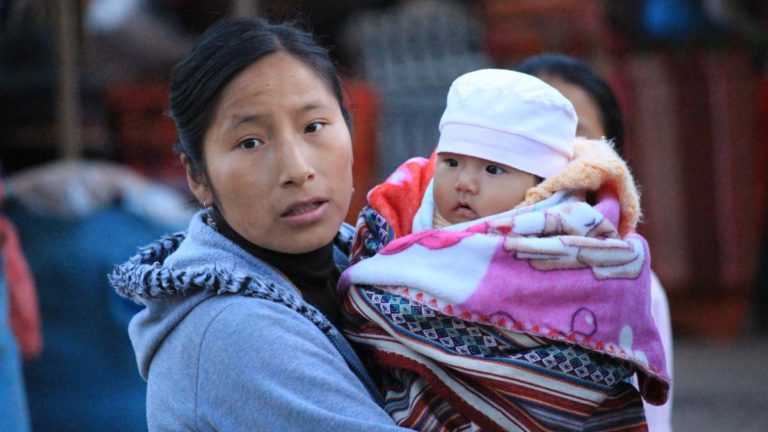A study in Latin America found that, given equal conditions, female household heads experience better living conditions than their male counterparts. The number of female-headed households has increased rapidly over the last decades as more and more people diverge from traditional relationship and livelihood arrangements. What does this mean for development actors and how is this trend to be seen in light of persisting inequalities?
In 1951, the clothing brand Van Heusen advertised ties with the blatantly patriarchal slogan “Show her it’s a man’s world”. The ad displays a woman who just made her husband food obediently kneeling on the side of a bed. In it, the man wearing a white shirt and tie smiles confidently interlocking his arms behind his head. Despite the exaggeration of this portrayal, it clearly defines the roles within the ‘ideal’ household during that time. The woman is responsible for domestic work and childcare. The man is the breadwinner and decision maker. Historically, strongly patriarchal structures in the household and society at large are the norm. In fact, only a few non-patriarchal societies have existed in the history of human civilisation. Reason enough for Lebanese artist Eli Rezkallah to turn the tables. In his versions of various old advertisements, the man is put into the subservient role previously attributed to women. Rezkallah’s work accentuates the misogyny that permeates patriarchal visions of the household and society and is a call for action against persisting gender inequality (check out the entire series In a Parallel Universe). The existence of such artworks illustrates that the tide is turning. Nowadays, women’s voices are stronger than ever. The importance of gender equality within the international development agenda as underpinned by the fifth Sustainable Development Goal sets a clear trajectory: The equality of women and men is a central feature of future societies.
In development, female-headed households have been a target group for many decades. Female household heads were assumed to be single mothers that faced the double burden of income generation and domestic work. Often, single mothers are stigmatized and receive only marginal support from their family or the father. From that perspective, female-headed households merely contribute to the feminization of poverty referring to the circumstance that poverty disproportionately affects women. However, the diversity of relationship and livelihood models today erodes the link between female headship and poverty. Nowadays, the man is not automatically the household head although that is usually still the case. Besides that, more women are living on their own in non-traditional relationship arrangements such as cohabitation, long-distance relationships, singlehood, separation, divorce and widowhood. Due to these changes, the proportion of female-headed households has increased in all regions of the world; in Latin America the ratio more than doubled between the 1970s and 2010, now ranging from 20 to 45 percent in the region. These numbers are probably still too low as women often underreport their headship.
A recent large-scale study comparing household assets in Latin America looked at the link between female headship and living conditions. Married couples living together remain the most advantaged group while all other groups live in worse conditions. However, across all other categories women tend to do better than men under the same conditions. One explanation is that women accumulate household resources rather than spending them and are often more responsible in reinvesting the assets they have. It is surely one of the reasons for poverty falling faster in female-headed households. This development is a chance not only for women themselves but especially for their children. Various governments across Latin America are aware of that and disburse conditional cash transfers, a form of social welfare, directly to women in attempt to break the poverty cycle and create upward social mobility. In that way, female-headed households transitioned from being a mere target for development actors to being a springboard for development themselves.
Unfortunately, these trends must be treated with caution as the overall picture is more complicated and the way to gender equality still long. Yes, women are often doing better than men under the same conditions, but this starting point is rarely given. The majority of female household heads in Latin America find themselves in worse living conditions than men, especially when it comes to labour participation, income generation and various non-income indicators of poverty such as discrimination and sexual violence. Gender inequality pervades all areas of life and single improvements only compile to a larger trend when they are accompanied by other advances. When working with female-headed households, intra-regional differences are considerable. In Brazil, Peru and El Salvador female household heads were usually still poorer than their male counterparts under the same conditions while the gap was negligible in other countries. It is telling that in a Gallup survey in 2012 and 2013, overall, women in Latin America where the least likely to say that they live in a country where women are treated with dignity and respect. It would thus be short-sighted to conclude that women in the region are doing great on their own and it is just a matter of time until we have full equity. Development actors should acknowledge what has been achieved until this point but gender equality is far from being reached. They must keep a nuanced view of female-headed households and base any work on a comprehensive understanding of a country’s welfare system and its legislation regarding family and social protection.
All over the world, women and everyone who is fighting for their rights have come a long way in their struggle for an equitable, gender-equal society. The fact that advertisements such as the one by Van Heusen are widely considered bizarre and outdated, illustrates that women today can lead more autonomous and free lives. As the developments in Latin America show, that is not only a chance for every single woman but a chance for future generations and the development of countries as a whole. In continuing to work towards equitable societies, we should neither trick ourselves by overestimating advances already made nor should we bury our heads in the sand in view of the profound inequalities that still exist. Women might not be ‘taking over’ yet – after all, the goal is gender equality – but by mindfully addressing persisting inequalities we can honor the progress made so far.


